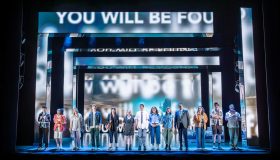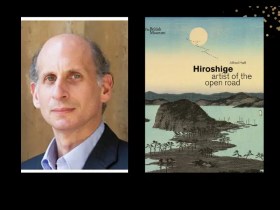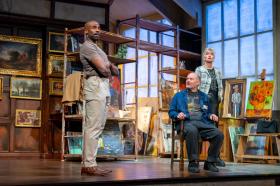On Monday we ran Part I of Joel Simpson’s review of Les Rencontres d’Arles, a huge lovesong to the art and social practice of photography set in the ancient and hyper-picturesque city of Arles, France. The town’s galleries, public spaces and a number of churches are filled with photo exhibits through September 16. Events, concerts and seminars on various aspects of photography continued throughout the summer. Here we take up Part II of Joel’s review, where he looks at Fifteen up-and-coming photographers were “sponsored” by recognized leaders in the field and presented as talent deserving wider recognition.
In one area of Les Ateliers Fifteen up-and-coming photographers were “sponsored” by recognized leaders in the field and presented as talent deserving wider recognition among these galleries of the Ateliers section. Of them I found three to be particularly provocative.
Eric Mutel (b. 1973, France) a visual artist practicing both photography and video subjects the emulsions of his portraits to freezing and liquefying processes. The results on display depicted the impassive heads of his subjects on surfaces that had been cracked rippled, squeezed and torn, with random pieces missing. It is a kind of regularized radical mordençage that in these very large, sepia toned portraits conveys a sense of profound disturbance.
Multi-media artist Cat Tuong Nguyen (b. 1969, Vietnam) takes us via his large photographs into a room with photographs taped up everywhere, propped up on chairs and on wooden boxes, amidst his lighting equipment and easels. It appears to be a studio. In it he’s managed to set off a considerable number of fireworks, which all seem to explode simultaneously, spewing the air with light trails and bursts. It becomes an image of two levels of chaos the one hot and the other cold, metaphors, perhaps for the terrible war against his country, or the way war has become a kind of grim celebration of fire power against cultures already in upheaval.
The disturbingly provocative work, however, was that of Joseph Mills (b. 1951, Wisconsin), whose absurdist retro photocollages mounted on laquered wood evoke the collages of engravings that Max Ernst created in the twenties and thirties. In one a little boy stands in a lab coat, rolling his eyes up into his lids, sticking out his tongue, while steam pours out of his ears—the perfect image of a temper tantrum. In another, a nurse with the head of a wolf pulls a pair of shorts down from the naked buttocks of her young male charge, who, sporting the face of a middle-aged androgyne kisses her on the snout. In another a man who is being shaved looks in surprise as the foot of a turkey pops out of a hole under his chin. Mills makes no attempt to hide the artifice: the boundaries between the separate images are mostly obvious. But this is not digital process photography with its concern for believability; it is absurdist statement using photographic means contrived to attach hypocrisy, complacency, and the abuse of trust, transgressions that normally unfold beneath the surface of the visual—or away from observing eyes.
Another building in the Ateliers complex also offered three collective exhibitions, each of which demonstrated of photography’s particular powers. Its power of immediacy, as first reporter of events was amply illustrated in the instructive retrospective on Magnum, that agency of photojournalists organized in 1947 by Henri Cartier-Bresson, and others. Unlike the extensive traveling Magnum show in 1989, which focused on the photographs themselves, this one was elaborately captioned (in French and English) explaining the circumstances and importance of each image, as well as displaying actual copies of out-of-print and ultra-rare books by Magnum members.
Photography’s power to overcome time was demonstrated in the series of photographs of Queen Elizabeth, QE II @ 80, from early childhood to her present as octogenarian, as the unique public figure alive today with such extensive personal documentation. At intervals along the way profiles of all her official photographers were listed at intervals. However one feels about the Queen, it was impossible not to be fascinated by this extensive document on human growth and aging, whose process inevitably accompanied the viewer’s own.
The third collective exposition, Madame la présidente, jumped the Channel to demonstrate photography’s imaginative power to twit politics. Here 41 photographers (only about a quarter of them female) were asked to create an image of an imaginary female president of France—given that France nearly had one in Ségoulène Royal, and that the US could elect one next year. The results ranged from deliberate incongruities, such as Carole Bellaiche’s nursing mother in front of the French flag (Mathilde and her daugher Antoinette), and David Tartakover’s woman in a burka, also in front of the flag, to the comic moquerie of Raphaël Dellaporta’s nude woman squeezing her breasts, her head covered with a paper bag displaying a portrait of perennial reactionary-racist candidate Jean-Marie LePen on it, entitled Le Pen Playing with His Breasts.
But there was much more to the festival. Back in the town center, many galleries and historical venues showed photographs, including the town hall and a number of deconsecrated churches. The most striking of these was the Alberto García-Alix (b. 1956, Spain) exhibition in the Eglise Sainte-Anne, a church that now amounts to little more than walls and vaulted ceilings. Garcia-Alix, an extensively tattooed survivor of drug addiction, presented a show full of sex, defiance and vulnerability, all large black and whites that seemed to amount to a visual cri de coeur. The town museum, le Musée Arletan, hosted a striking show on the traditional textile industry of Armenia, including 100+ year old images and samples of the classic weaves. The Espace Van Gogh, a large quadrilateral building enclosing a brilliant garden, hosted a lively market in used photo books under the open-air galleries, while inside were two astonishing documentary shows. The first one drew from Alkazi archive, an extensive collection of photographs from Asian cultures collected by Ebrahim Alkazi (b. 1925, India) part of which is housed in New York’s Sepia Gallery (143 West 26th Street) and the rest in London and New Dehli.
The Alkazi show featured Indian photography and was divided into two parts.
The first offered a retrospective of Indian polymath photographer Umrao Singh Sher-Gil (1870-1954), who documented himself and his family (which included his famous painter daughter Amrita, who died at age 28 in 1941) over a sixty year period beginning in 1882, including experiments with autochromes (early color photography), double- and time-exposure portraits, and stereoscopic photographs. The setting is pure grande bourgeoisie, recognizably Victorian, to which the Indian ethnicity imparts a wonderful flavor. Sher-Gil includes portraits of himself in flowing white beard dressed only in a loin cloth and later as a turbaned old man later in life, giving a new dimension to the notion of Victorian eccentric.
The second, entitled India: Princely Traditions/Modern Vision featured albums and photographs of Indian aristocracy. The albums, glued to long tables arranged in parallel through two rooms, documented the official lives of the wealthy class that the British propped up, the better to rule the country. The expressions of these well-fed broadly mustachioed gentlemen and sari-draped women, range from blank to smug. The most prominent men, viz. the Maharajahs, wear a dozen or so pearl necklaces to set off their medaled and jeweled clothing and turban. This show continues with a display of formal photographic hand colored portraits in which gold buttons and jewelry have been added on in opaque paint. The effect is garishly bizarre, becoming a document of the pretentious taste of this artificially exalted class.
On the second floor of the Espace Van Gogh a hitherto unknown treasure of jazz photographs was on display. They were the Polaroids taken by the Baroness Pannonica von Koenigswarter (1913-1988), the renegade French aristocrat who lived across the river from New York City, where she played the role of guardian angel to jazz musicians for nearly forty years. Thelonious Monk even spent the last ten years of his life (after he had stopped playing) living with his wife in Pannonica’s Weehawkin, New Jersey, attic (d. 1982). One of his best ballads is famously named “Pannonica” for her, as is one of Horace Silver’s most engaging Latin/swing tunes, “Nica’s Dream.”
If you’re accustomed to seeing these musicians in the iconic jazz photography of William Gottlieb or Martin Williams, you’ll be delighted to see them relaxing, having fun, and clowning around with each other in these charming snapshots, taken between 1961 and 1966. There’s the young Miles Davis, shirt open, leaning back in a 50’s designer chair, legs wide open, Monk showing Dizzy something on the piano or gazing over the Hudson on her balcony, and photos of Cannonball Adderley, Sonny Rollins, Max Roach, Horace Silver, Max Roach, Sun Ra among many others. Ironically, Pannonica’s granddaughter, Nadine de Koenigswarterexperienced great difficulty finding a publisher when she decided to share these images with the public. She gave up on the US and found a small Paris publication house, Buchet-Chastel, to issue a minimal edition of 3000 copies last November. To everyone but Nadine’s (one supposes) surprise, they sold out before Chirstmas. Hopefully, there will be a second edition, and dare one hope? a US/English language edition, too.




